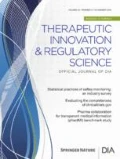Abstract
For approval of a drug product, the United States Food and Drug Administration (FDA) requires that substantial evidence of the effectiveness and safety of the drug product be provided through the conduct of two adequate, well-controlled clinical trials. To assist the sponsors in preparation of final clinical reports for regulatory submission and review, the FDA and other regulatory agencies and conferences such as the International Conference on Harmonization (ICH) have developed guidelines for the format and content of a clinical report. The FDA and ICH guidelines require that the following statistical issues be addressed in the final clinical report: I. Baseline comparability, 2. Adjustments for covariates, 3. Dropouts or missing values, 4. Interim analyses and data monitoring, 5. Multicenter studies, 6. Multiplicity, 7. Intention-to-treat subset versus efficacy subset, 8. Active control trials, and 9. Subgroup analyses. This paper provides an overview of these statistical issues. In addition, statistical justification for these issues is also addressed.
Similar content being viewed by others
References
FDA. Guideline for the Format and Content of the Clinical and Statistical Sections of New Drug Applications. Rockville, MD: U.S. Food and Drug Administration; 1988.
Committee for Proprietary Medicinal Products. A Note for Guidance on Biostatistical Methodology in Clinical Trials in Applications for Marketing Authorizations for Medicinal Products. Brussels, Belgium: CPMP; 1995.
ICH. ICHHarmonized Tripartite Guideline on Structure and Content of Clinical Study Reports. Recommended for adoption at Step 4 of the ICH Process on November 30, 1995 by the ICH Steering Committee.
Little RJA, Rubin DB. Statistical Analysis with Missing Values. New York, New York: John Wiley & Sons; 1987.
Diggle PJ, Liang KY, Zeger SL. Analysis of Logitudi-nal Data. New York, New York: Oxford Science Publications; 1994.
PMA. Issues in data monitoring and interim analysis in the pharmaceutical industry. The PMA Biostatis-tics and Medical Ad Hoc Committee on Interim Analysis. Pharmaceutical Manufacturing Association; 1989.
Williams GW, Davis RL, Geston AJ, Gould AL, Hwang IK, Mathews H, Shih WJ, Snapinn SM, Wal-ton-Bowen KL. Monitoring of clinical trials and interim analyses for a drug sponsor’s point of view. Stat Med. 1993;12:481–492.
O’Neill RT. Some FDA perspectives on data monitoring in clinical trials in drug development. Stat Med. 1993;12:601–608.
Nevius SE. Assessment of evidence from a single multicenter trial. Proceedings of the Biopharmaceutical Section of the American Statistical Association; 1988:43–45.
Lewis JA. Statistical issues in the regulation of medicine. Stat Med. 1995;14:127–136.
Gail M, Simon R. Testing for qualitative interations between treatment effects and patient subsets. Biometrics. 1985;41:361–372.
Hochberg Y. A sharper Bonferroni’s procedure for multiple tests of significance. Biometrika. 1988;75:800–803.
Dunnett CW. A multiple comparison procedure for comparing several treatments with a control. J Am Stat Assoc. 1955;50:1096–1121.
Dunnett CW, Goldsmith CH. When and how to do multiple comparisons. In Statistics in the Pharmaceutical Industry. Buncher CR, Tsay JY, eds. New York, New York: Marcel Dekker, Inc.; 1995.
Capizzi T, Zhang J. Testing the hypothesis that matters for multiple primary endpoints. Drug Inf J. 1996; 30:949–956.
O’Brien PC. Procedures for comparing samples with multiple endpoints. Biometrics. 1984;40:1079–1087.
Pocock SJ, Geller NL, Tsiatis AA. The analysis of multiple endpoints in clinical trials. Biometrics. 1987;43:487–498.
Tang DI, Geller NL, Pocock SJ. On the design and analysis of randomized clinical trials with multiple endpoints. Biometrics. 1993;49:23–30.
Pledger GW, Hall D. Active control trials: do they address the efficacy issue? Proceedings of the Bio-pharmaceutical Section of the American Statistical Association: 1986:1–7.
Temple R. Difficulties in evaluating positive control trials. Proceedings of the Biopharmaceutical Section of the American Statistical Association: 1983:1–7.
Author information
Authors and Affiliations
Rights and permissions
About this article
Cite this article
Pong, A., Chow, SC. Statistical/Practical Issues in Clinical Trials. Ther Innov Regul Sci 31, 1167–1174 (1997). https://doi.org/10.1177/009286159703100415
Published:
Issue Date:
DOI: https://doi.org/10.1177/009286159703100415




